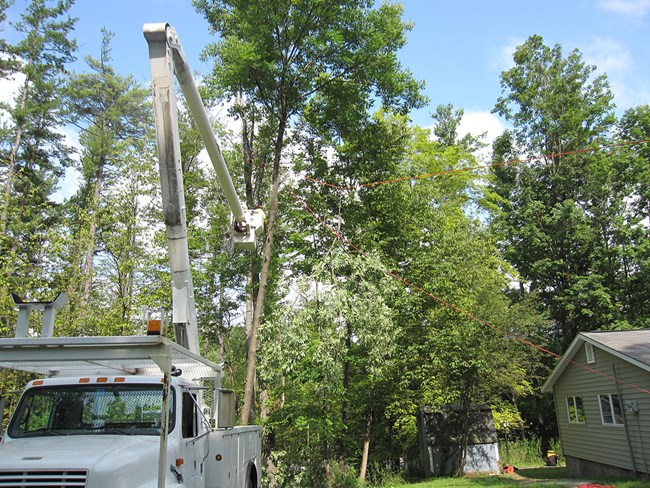Last updated: May 12, 2017
Article
Wildland Fire: Hazardous Fuel Loading Reduced through Mechanical Operations

Saratoga National Historical Park (SARA) is the site of the first significant American victory of the American Revolutionary War. The park is located on the upper Hudson River, New York, and includes 3,400 acres of land categorized as:
- 2,300 acres (68%) of mixed hardwoods and white pine forest
- 800 acres (27%) of grassland
- 300 acres of a combination of other vegetation and developed areas.

In August 2012, crews undertook a mechanical fuels reduction project to remove hazardous fuels on 15 acres of land surrounding park structural complexes. The goal was to establish fire-adapted community conditions and reduce threats to park structures from future wildfires.
The buildup of hazardous fuels that threatens infrastructure in SARA dates back to 2008, when a severe ice storm created a tremendous amount of tree damage, including broken tree tops and branches, hazardous snags, and downed trees throughout the park. Following the storm, the Northeast Region’s Olmsted Center for Landscape Preservation (OCLP) coordinated a National Park Service (NPS) team of certified arborists and arborist-trainees to mitigate hazards along the auto tour road and tour stops. Mitigation was limited to improving life safety conditions at the park. Tree damage and fuel loading issues adjacent to park structures, such as the administrative or maintenance complexes, and undeveloped areas were not addressed at that time.

NPS / Dan McCarthy
Since the storm, SARA managers investigated funding opportunities for mitigation of the fuel hazards immediately surrounding the park’s structural complexes. The right opportunity came along in 2012 through collaboration with the NPS Northeast Region’s North Country Fire Management (NCFM) program based at Acadia National Park. Staff from the NCFM were asked to address the fuel loading issues within the wildland urban interface zone adjacent to the park structures. After assessing the issues, the NCFM operations and fuels manager, Fred Mason, determined that trained arborists were required due to the complexity and safety issues in removing hazard trees in close proximity to structures. The operations and fuels manager also identified another concern in the work area: numerous beech trees were damaged by beech bark disease. These dead and dying trees added to the hazardous fuel load and further complicated safety concerns.
The NCFM obtained hazardous fuel reduction funding from the NPS Northeast Regional Office to use the NPS Northeast Region Arborist Incident Response (AIR) team for the project. The AIR team was chosen because of their experience with removal of large-diameter, standing dead and storm-damaged trees in close proximity to structures. The AIR team had to dismantle many trees in sections by climbing and using rope and saddle methods and advanced rigging techniques.
During the week of August 12–17, 2012, the AIR team, with support from other regional teams and SARA park staff, conducted the mechanical fuels loading reduction project in the forested area surrounding the administrative complex. This complex includes the ranger station, administrative offices, and the curatorial archives building. All three buildings have adjacent fuel oil storage tanks. The ranger station houses the park’s communication center, including radios, information technology servers, and a phone system. The curatorial archives building houses park archives, including priceless artifacts and historical documents.

NPS / Fred Mason
The forested area surrounding the maintenance complex was also included in the project due to the life safety hazard and the secondary safety issue related to hazardous materials, should they be threatened by fire. The maintenance complex consists of seven buildings that house tools, equipment, vehicles, fuel storage tanks, gas and diesel pumps, a paint storage area, and black powder and hazardous materials storage.
An incident action plan detailing treatment, debris management and disposal, safety, and communications guided the five days of work. Input from SARA resource and park management staff was solicited to meet goals identified in the park’s cultural landscape treatment plan.
The project area totaled 15 acres; it was divided into six treatment zones. An estimated 200 standing trees of varying diameters up to 20 inches diameter at breast height were removed from the forested areas during the project. Downed trees, broken and hanging branches, and woody forest floor debris were also removed.
Material less than five inches in diameter was chipped and scattered or used in other designated areas of the park. Hardwood logs were collected for distribution to low income area families for firewood, facilitated through a partnership with the New York State Department of Corrections. Softwood debris was stacked into burn piles. Piles will be burned by NPS Northeast Regional fire personnel during winter 2013.

NPS / Fred Mason
The successful completion and excellent safety record of the project was a direct result of the planning and coordination that went into the fuels reduction project. The resulting defensible space surrounding the administrative complex and maintenance fuel storage tanks makes the structures less vulnerable to wildfire.
SARA managers continue to collaborate with the North Country Fire Management program to actively manage risks associated with hazardous fuels and wildfire. The park is pursuing future sources of funding to address the remaining areas in need of fuels reduction mitigation. SARA also continues efforts to restore and maintain the treasured battlefield and forest landscapes by using prescribed fire as allowed within the park’s cultural landscape treatment plan.
Contact: Andy Mitchell, Acadia/North Country fire management officer
Email: Andy_Mitchell@nps.gov
Phone: (207) 288-8780
